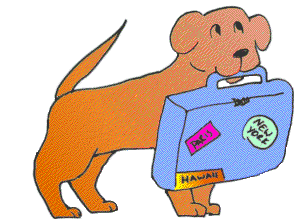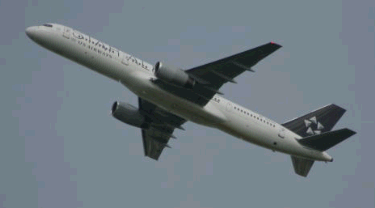|
TRAVELING WITH YOUR PET

Summer and Holiday seasons turn into USDA Health Certificate Seasons at animal hospitals nationwide.
If you are planning air travel with your pet, here are some things you need to know:

(original graphic by marvistavet.com)
Travel is stressful enough without having to worry about how the pet will fare in a carrier surrounded by noise and unfamiliar people. Horror stories abound. Still, most travel disasters stem from one of three issues (all of which are readily preventable).
- Do not open the carrier for a final petting or hug before travel as the pet can escape. If security requires you to remove the pet from the carrier, you may request that this be done in a room where escape is not possible.
- Do not use a low quality carrier that can open or break.
- Do get your pet used to being inside the carrier prior to travel so as to minimize anxiety. Keep in mind that brachycephalic (short-faced) dog breeds may have difficulty breathing when agitated (see below). Proper planning makes for a fun excursion for every member of the family, even the furry ones.
FLYING WITH YOUR PET IN THE CABIN WITH YOU
- Most airlines allow pets weighing 15 lbs or less to fly in the cabin with their owners (this weight includes both the pet and the carrier). This also means the carrier must fit under the seat in front of you. Check with the airline about the carrier size and dimensions. Most airlines sell carriers or you can buy one from a pet supply store.
- Be sure to confirm with the airline the day before travel that your pet is coming with you.
- Remember that you will need a USDA Health Certificate in most cases. The USDA considers a health certificate good for 30 days but many airlines have their own ideas about how long a health certificate should be valid (10 days is typical for domestic travel). Check with the airline to see what kind of timing they require for their required paperwork and exactly what they want you to bring.
- Some states require special vaccinations. Travel to most foreign countries now requires special notarization of the certificate by the USDA and some countries require special blood tests for entry. Always be sure to check with the consulate regarding what you need; however, the USDA link below should be accurate. Foreign travel will require plenty of time for proper paperwork notarization.
- Some animals may be stressed or frightened by travel. Consider tranquilizers. If your pet is traveling in the cabin with you, you may just want to have them on hand in case of unexpected anxiety.
- Emotional support animals and service animals generally fly for free and do not have to be confined to a carrier. This may sound like just what you want but keep in mind that the airline is unlikely to simply take your word that your pet is an emotional support or service animal. If you have documentation, you are likely to need it and some airlines have specific forms that must be filled out by your health professional and/or veterinarian.
YOUR PET AS CHECKED LUGGAGE OR MANIFEST CARGO
|
So what if your pet is too big for cabin travel? You can have your pet travel as checked luggage or as manifest cargo. But what is the difference? In both situations, the pet travels in a pressure and temperature controlled hold. It turns out that cargo is probably a better experience for your pet. In fact, many airlines no longer allow for pets to fly as checked luggage for reasons that will become obvious below.
|
 (Photocredit: Morguefile.com) (Photocredit: Morguefile.com) |
|
CHECKED LUGGAGE (COULD SAVE MONEY BUT PROBABLY NOT WORTH REDUCED SAFETY)
- Check in happens at main terminal.
- You must accompany your pet on the same flight. If you are not flying yourself, your pet will need to be in cargo. Checked luggage is not an option if you are not flying on the same plane as the pet.
- Personnel are generally trained to handle luggage, not live animals.
- Charged as a flat fee rather than by weight which usually works out cheaper than cargo.
- Transport vehicles moving across tarmac are not required to be temperature controlled. Often these vehicles are open to the air and raw environmental temperature for unspecified time periods.
MANIFEST CARGO
- Check in happens at cargo entrance.
- Personnel are trained to handle live animals and their enclosures.
- Generally more expensive and charged by weight.
- Transport vehicles are temperature controlled and protected from the environment.
Regardless of whether you choose cargo or checked luggage, each airline will have additional requirements and you will need to check with the specific airline to get most of these. For example, some airlines have maximum weight requirements. Be sure to check for any restrictions. Most states will not accept animals younger than 8 weeks of age. Such youngsters will not be allowed to travel by air. As of December 2020, airlines may not prohibit transport based on breed per se but they may have safety restrictions as for brachycephalic/short faced breeds.
Guidelines for animal shipping are set by the International Air Travel Association (IATA). These include the size of the shipping container, how it must be marked, how it is ventilated and how food and water should be made available. A copy of the guidelines can be viewed here:
www.iata.org/whatwedo/cargo/live-animals/Documents/pet-container-requirements.pdf
|
YOUR PET AS CHECKED LUGGAGE OR MANIFEST CARGO
According to the Animal Welfare Act, there are specific temperature guidelines to which airlines must adhere.
Ambient temperatures in holding areas for cats and dogs must not fall below 45 degrees F for more than 4 consecutive hours.
Dogs and cats must not be exposed to temperatures below 45 degrees for more than 45 minutes when being moved to or from a holding areas.
Animals transported as carry-ons are not protected under the Animal Welfare Act,
so it is up to the person carrying them to see that they do not become too cold or overheated.
Consider a Microchip ID for any pet that travels.
For more details: www.pettravel.com/passports_container_requirements.cfm
We wish easy travel and a pleasant journey to everyone transporting their pets.
|
At the present time, Delta Airlines and United Airlines no longer accept animals as checked luggage. They must fly as cargo or in the cabin (if appropriate requirement for in-cabin travel are met). |
|

HELPFUL LINKS
For Airline Requirements for Pet Travel By Airline:
www.pettravel.com/site-map-pet-friendly-airline-rules-regulations.cfm
For USDA Regulations for Bringing a Pet to Another State or To a Foreign Country:
https://www.aphis.usda.gov/pet-travel
For services to assist with travel and paperwork:
PetRelocation.com
Flywithmypet.com
For more pet travel resources such as pet friendly lodging:
PetsWelcome.com
DogFriendly.com
For further Air Travel Tips including a guide to In-terminal Pet Relief Stations:
www.cheapflights.com/news/pet-travel/
For General tips on Traveling with Pets:
www.bookmundi.com/t/tips-for-traveling-with-pets
Please contact us if you need further information in preparation for travel.


Page last updated: 7/23/2025
|